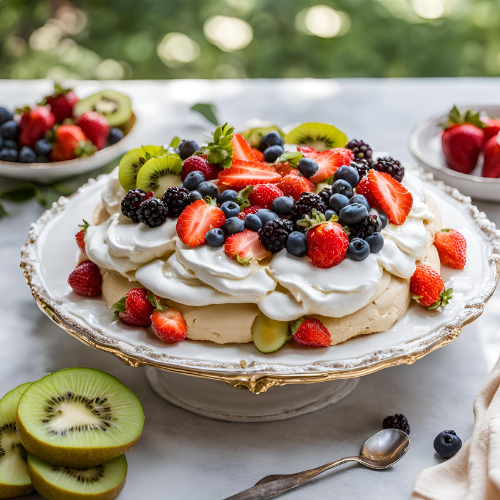Introduction
Pavlova is a beloved dessert that has graced tables for decades with its light, airy meringue base, topped with a bounty of fresh fruits and whipped cream. Named after the famous Russian ballerina Anna Pavlova, this dessert is celebrated for its delicate balance of textures and flavors. The crisp exterior and marshmallow-like interior of the pavlova make it a crowd-pleaser at any gathering. In this guide, we’ll walk you through the steps to create the perfect pavlova from scratch, ensuring you achieve that ideal balance every time. Whether you’re a seasoned baker or a beginner, this step-by-step guide will help you master this elegant dessert with ease. Let’s dive into the world of pavlova and discover the secrets to making it flawless!
For more dessert ideas, check out our Delightful Fruit-Based Dessert Recipes for Every Occasion and Granita: The Ultimate Guide to Making Perfect Granita
Table of Contents
Ingredients for the Perfect Pavlova

To create a perfect pavlova, you’ll need the following key ingredients that ensure its light, crisp meringue and delightful toppings:
- Essential Ingredients:
- Egg Whites: The main component for meringue. Use room temperature egg whites for best results.
- Sugar: Granulated sugar helps stabilize the egg whites and adds sweetness.
- Cornstarch: Helps create a crisp exterior and soft interior.
- Vinegar: Provides stability to the meringue.
- Vanilla Extract: Adds a subtle flavor.
- Toppings:
- Fresh Fruits: Strawberries, kiwis, berries, or any seasonal fruits add color and flavor.
- Whipped Cream: Light and airy, it complements the meringue perfectly.
- Mint Leaves: For a fresh, decorative touch.
- Tools You’ll Need:
- Electric Mixer: Essential for beating the egg whites to stiff peaks.
- Baking Sheet: To shape and bake the meringue.
- Parchment Paper: Prevents the meringue from sticking to the baking sheet.
- Mixing Bowls: For mixing ingredients.
- Spatula: For shaping the meringue.
If you’re new to baking, our 25 Essential Cooking Tips for Beginners can help you get started.
Step-by-Step Instructions to Make Pavlova

Follow these detailed steps to create a perfect pavlova with a crisp exterior and soft, marshmallow-like interior:
- Preparing the Meringue:
- Beat Egg Whites: Start by beating the egg whites in a clean, dry mixing bowl using an electric mixer at medium speed until they form soft peaks.
- Gradually Add Sugar: Slowly add sugar, one tablespoon at a time, while continuing to beat the egg whites. This ensures the sugar dissolves properly and helps stabilize the meringue.
- Add Cornstarch and Vinegar: Gently fold in the cornstarch and vinegar with a spatula to achieve a smooth, glossy mixture.
- Shaping and Baking:
- Form the Meringue: Preheat your oven to 300°F (150°C). Line a baking sheet with parchment paper and spoon the meringue mixture onto it, shaping it into a circle with slightly higher edges.
- Bake: Reduce the oven temperature to 250°F (120°C) and bake for about 1 hour. The meringue should be crisp on the outside and slightly soft inside. Turn off the oven and leave the meringue inside to cool completely.
- Cooling and Decorating:
- Cool Completely: Ensure the meringue is fully cooled before adding toppings to prevent it from becoming soggy.
- Add Toppings: Spread a layer of whipped cream over the cooled meringue and top with fresh fruits. Add a few mint leaves for decoration.
Tips and Tricks for a Perfect Pavlova
Creating a perfect pavlova requires some attention to detail and a few expert tips. Here are some tricks to ensure your pavlova turns out flawlessly every time:
- Perfect Meringue Every Time:
- Use Room Temperature Egg Whites: They whip up more easily and achieve greater volume.
- Clean Equipment: Ensure your mixing bowl and beaters are completely clean and free from any grease, as this can prevent the egg whites from whipping properly.
- Slow Addition of Sugar: Adding sugar gradually allows it to dissolve fully, preventing a grainy texture.
- Avoiding Common Mistakes:
- Prevent Weeping: Make sure the sugar is fully dissolved in the egg whites to avoid liquid seeping from the meringue.
- Prevent Cracking: Avoid opening the oven door during baking, as sudden temperature changes can cause cracks.
- Prevent Sinking: Let the meringue cool completely in the oven with the door slightly ajar to prevent it from collapsing.
- Variations and Additions:
- Flavored Pavlova: Add a splash of lemon juice or a sprinkle of cocoa powder to the meringue for a different flavor.
- Different Toppings: Experiment with various fruits, chocolates, or nuts for unique presentations and tastes.
Variations and Additions

Pavlova is a versatile dessert that can be customized to suit different tastes and occasions. Here are some variations and additions to try:
- Flavored Pavlova:
- Chocolate Pavlova: Add 1-2 tablespoons of cocoa powder to the meringue mixture for a rich, chocolatey base. Top with whipped cream and chocolate shavings.
- Lemon Pavlova: Fold in some lemon zest into the meringue mixture for a zesty twist. Top with lemon curd and fresh berries.
- Different Toppings:
- Tropical Fruits: Use mango, pineapple, and passion fruit for a tropical twist. These fruits add a burst of color and a refreshing taste.
- Nutty Delight: Sprinkle chopped nuts like pistachios, almonds, or hazelnuts on top of the whipped cream for added crunch and flavor.
- Mini Pavlovas:
- Instead of making one large pavlova, create individual mini pavlovas. This is perfect for parties and allows guests to have their own personal dessert. Shape smaller meringue nests and reduce the baking time accordingly.
Frequently Asked Questions about Pavlova
To help you perfect your pavlova, here are answers to some common questions:
- Can I Make Pavlova Ahead of Time?
- Yes, you can make the meringue base ahead of time and store it in an airtight container for up to two days. Add the whipped cream and fruit toppings just before serving to keep it fresh and crisp.
- Is Pavlova Gluten-Free?
- Yes, pavlova is naturally gluten-free as it is made from egg whites, sugar, cornstarch, and vinegar. If you need a dairy-free version, simply use a dairy-free whipped cream.
- What Fruits Work Best as Toppings?
- Fresh, seasonal fruits work best as toppings for pavlova. Some popular choices include strawberries, kiwis, blueberries, raspberries, and passion fruit. These fruits add a vibrant color and complement the sweetness of the meringue.
- How Long Does Pavlova Last?
- Pavlova is best enjoyed the day it is assembled. However, the meringue base can be stored in an airtight container at room temperature for up to two days. Once topped with whipped cream and fruits, it should be consumed within a few hours to maintain its texture.
Conclusion
Creating the perfect pavlova is a delightful culinary adventure that brings joy to both the maker and the eater. By following this step-by-step guide, you can achieve a pavlova with a crisp exterior, soft and marshmallow-like interior, and beautifully adorned with fresh fruits and whipped cream. Whether it’s for a festive celebration or a simple gathering, pavlova is sure to impress. Give this recipe a try and share your results with us. Happy baking!
For more delicious recipes, check out our How to Make the Perfect Lasagna: Step-by-Step Guide and 25 Essential Cooking Tips for Beginners.

